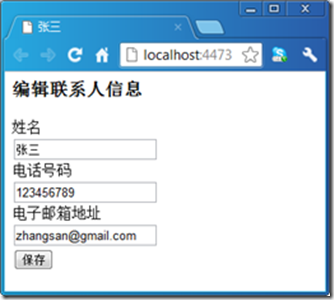ASP.NET MVC的Razor引擎:RazorViewEngine
2012-09-07 09:10
465 查看
[code] public class SimpleRazorViewEngine: IViewEngine
{ private string[] viewLocationFormats = new string[]{ "~/Views/{1}/{0}.cshtml","~/Views/{1}/{0}.vbhtml","~/Views/Shared/{0}.cshtml","~/Views/Shared/{0}.vbhtml"}; private string[] areaViewLocationFormats = new string[]{ "~/Areas/{2}/Views/{1}/{0}.cshtml","~/Areas/{2}/Views/{1}/{0}.vbhtml","~/Areas/{2}/Views/Shared/{0}.cshtml","~/Areas/{2}/Views/Shared/{0}.vbhtml"};public ViewEngineResult FindPartialView(ControllerContext controllerContext, string partialViewName, bool useCache)
{return FindView(controllerContext, partialViewName, null, useCache);
}
public ViewEngineResult FindView(ControllerContext controllerContext, string viewName, string masterName, bool useCache)
{ string controllerName = controllerContext.RouteData.GetRequiredString("controller");object areaName;
List<string> viewLocations = new List<string>();
Array.ForEach(viewLocationFormats, format => viewLocations.Add(string.Format(format, viewName, controllerName)));
if (controllerContext.RouteData.Values.TryGetValue("area", out areaName)){Array.ForEach(areaViewLocationFormats, format=>viewLocations.Add(string.Format(format,viewName,controllerName, areaName)));
}
foreach (string viewLocation in viewLocations)
{string filePath = controllerContext.HttpContext.Request.MapPath(viewLocation);
if (File.Exists(filePath))
{return new ViewEngineResult(new SimpleRazorView(viewLocation), this);
}
}
return new ViewEngineResult(viewLocations);
}
public void ReleaseView(ControllerContext controllerContext, IView view)
{IDisposable disposable = view as IDisposable;
if (null != disposable)
{disposable.Dispose();
}
}
}
[/code]
[/code]
我们完全按照上面介绍的路径顺序搜索指定的目标View。简单起见,我们在对目标View进行搜索时忽略了指定的布局文件名和对ViewEngineResult的缓存。这个自定义的SimpleRazorViewEngine在Global.asax中通过如下的代码对进行注册。
[code] [code] public class MvcApplication : System.Web.HttpApplication
{protected void Application_Start()
{//其他操作
ViewEngines.Engines.Clear();
ViewEngines.Engines.Add(new SimpleRazorViewEngine());
}
}
[/code]
[/code]
我们定义了如下一个HomeController:
[code] [code] public class HomeController : Controller
{public ActionResult Index()
{Contact contact = new Contact
{ Name = "张三",
PhoneNo= "123456789",
EmailAddress = "zhangsan@gmail.com"
};
return View(contact);
}
}
public class Contact
{ [DisplayName("姓名")] public string Name{ get; set;} [DisplayName("电话号码")] public string PhoneNo{ get; set;} [DisplayName("电子邮箱地址")] public string EmailAddress{ get; set;}}
[/code]
[/code]
我们的View很简单。如下面的代码片断所示,这是一个Model类型为Contact的强类型View,在该View中我们直接调用HtmlHelper<TModel>的扩展方法EditorForModel将作为Model的Contact对象以编辑模式呈现在一个表单之中。
[code] [code] @model Contact
@{ViewBag.Title = Model.Name;
}
@using (Html.BeginForm())
{ @Html.EditorForModel()
<input type="submit" value="保存" />
}
[/code]
[/code]
为了验证我们自定义的SimpleRazorView对布局文件和_ViewStart页面的支持,我们在“~/Views/Shared/”目录下定义了如下一个名为“_Layout.cshtml”的布局文件。布局文件的设置通过定义在“~/Views/”目录下具有如下定义的“_ViewStart.cshtml”文件来指定。
[code] [code] _Layout.cshtml:
<html>
<head>
<title>@ViewBag.Title </title>
</head>
<body>
<h3>编辑联系人信息</h3>
@RenderBody()
</body>
</html>
_ViewStart.cshtml:
@{Layout = "~/Views/Shared/_Layout.cshtml";
}
[/code]
[/code]
运行我们的程序后会在浏览器中呈现如下图所示的输出结果,可以看出这和我们直接在Action方法Index中返回一个ViewResult对象没有什么不同。

ASP.NET MVC的Razor引擎:View编译原理
ASP.NET MVC的Razor引擎:RazorView
ASP.NET MVC的Razor引擎:IoC在View激活过程中的应用
ASP.NET MVC的Razor引擎:RazorViewEngine
相关文章推荐
- ASP.NET MVC:自定义RazorViewEngine视图引擎
- ASP.NET MVC的Razor引擎:RazorViewEngine
- Asp.net MVC 移除视图引擎(WebFormViewEngine或者RazorViewEngine)
- ASP.NET MVC的Razor引擎二:RazorView、RazorViewEngine
- A Look at the Razor View Engine in ASP.NET MVC
- ASP.NET MVC 重写RazorViewEngine实现多主题切换
- ASP.NET MVC的Razor引擎:RazorView
- ASP.NET MVC的Razor引擎一:View编译原理
- ASP.NET MVC的Razor引擎:RazorView
- ASP.NET MVC的Razor引擎:IoC在View激活过程中的应用
- ASP.NET MVC的Razor引擎:View编译原理
- asp.net mvc 用自定义的RazorViewEngine实现主题的自由切换遇到的问题!
- ASP.NET MVC的Razor引擎:View编译原理
- ASP.NET MVC的Razor引擎:View编译原理
- ASP.NET MVC的Razor引擎:IoC在View激活过程中的应用
- ASP.NET MVC自定义视图引擎ViewEngine 创建Model的专属视图
- asp.net mvc (4) - 自定义视图引擎 View/ViewEngine
- ASP.NET MVC - 定制属于你自己的ViewEngine
- ASP.NET MVC 3 Razor 视图引擎 基本语法
- 我要学ASP.NET MVC 3.0(七): MVC 3.0 新的Razor引擎
